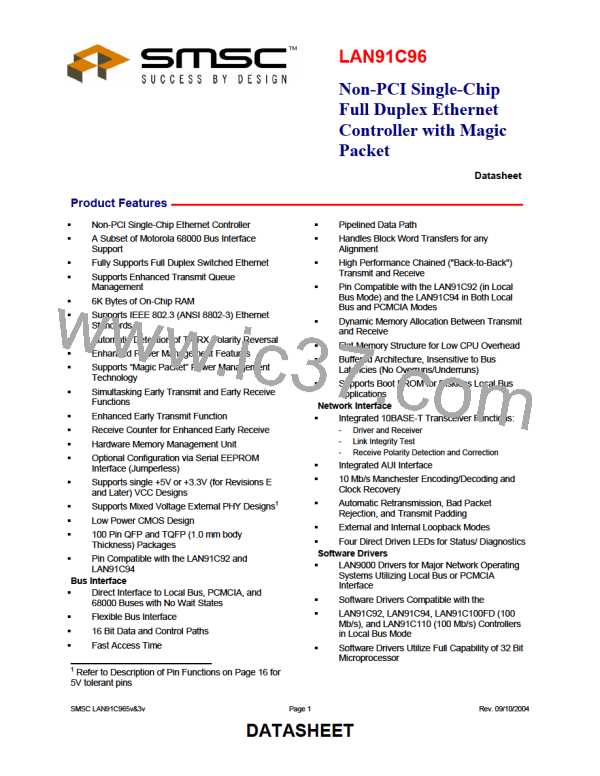Non-PCI Single-Chip Full Duplex Ethernet Controller with Magic Packet
MEMORY PARTITIONING
Unlike other controllers, the LAN91C96 does not require a fixed memory partitioning between transmit and
receive resources. The MMU allocates and de-allocates memory upon different events. An additional
mechanism allows the CPU to prevent the receive process from starving the transmit memory allocation.
Memory is always requested by the side that needs to write into it, that is: The CPU for transmit or the
CSMA/CD for receive. The CPU can control the number of bytes it requests for transmit but it cannot
determine the number of bytes the receive process is going to demand. Furthermore, the receive process
requests will be dependent on network traffic, in particular on the arrival of broadcast and multicast
packets that might not be for the node, and that are not subject to upper layer software flow control.
In order to prevent unwanted traffic from using too much memory, the CPU can program a "memory
reserved for transmit" parameter. If the free memory falls below the "memory reserved for transmit" value,
MMU requests from the CSMA/CD block will fail and the packets will overrun and be ignored. Whenever
enough memory is released, packets can be received again. If the reserved value is too large, the node
might lose data which is an abnormal condition. If the value is kept at zero, memory allocation is handled
on first-come first-served basis for the entire memory capacity.
Note that with the memory management built into the LAN91C96, the CPU can dynamically program this
parameter. For instance, when the driver does not need to enqueue transmissions, it can allow more
memory to be allocated for receive (by reducing the value of the reserved memory). Whenever the driver
needs to burst transmissions it can reduce the receive memory allocation. The driver program the
parameter as a function of the following variables:
1. Free memory (read only register)
2. Memory size (read only register)
The reserved memory value can be changed on the fly. If the MEMORY RESERVED FOR TX value is
increased above the FREE MEMORY, receive packets in progress are still received, but no new packets
are accepted until the FREE MEMORY increases above the MEMORY RESERVED value.
INTERRUPT GENERATION
The interrupt strategy for the transmit and receive processes is such that it does not represent the
bottleneck in the transmit and receive queue management between the software driver and the controller.
For that purpose there is no register reading necessary before the next element in the queue (namely
transmit or receive packet) can be handled by the controller. The transmit and receive results are placed
in memory.
The receive interrupt will be generated when the receive queue (FIFO of packets) is not empty and receive
interrupts are enabled. This allows the interrupt service routine to process many receive packets without
exiting, or one at a time if the ISR just returns after processing and removing one.
There are two types of transmit interrupt strategies:
1. One interrupt per packet.
2. One interrupt per sequence of packets.
The strategy is determined by how the transmit interrupt bits and the AUTO RELEASE bit are used.
TX INT bit - Set whenever the TX completion FIFO is not empty.
TX EMPTY INT bit - Set whenever the TX FIFO is empty.
AUTO RELEASE - When set, successful transmit packets are not written into completion FIFO, and their
memory is released automatically.
SMSC DS – LAN91C965v&3v
Page 75
Rev. 09/10/2004
DATASHEET

 SMSC [ SMSC CORPORATION ]
SMSC [ SMSC CORPORATION ]